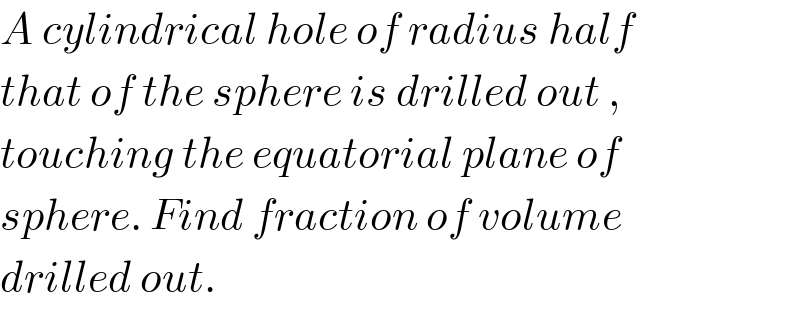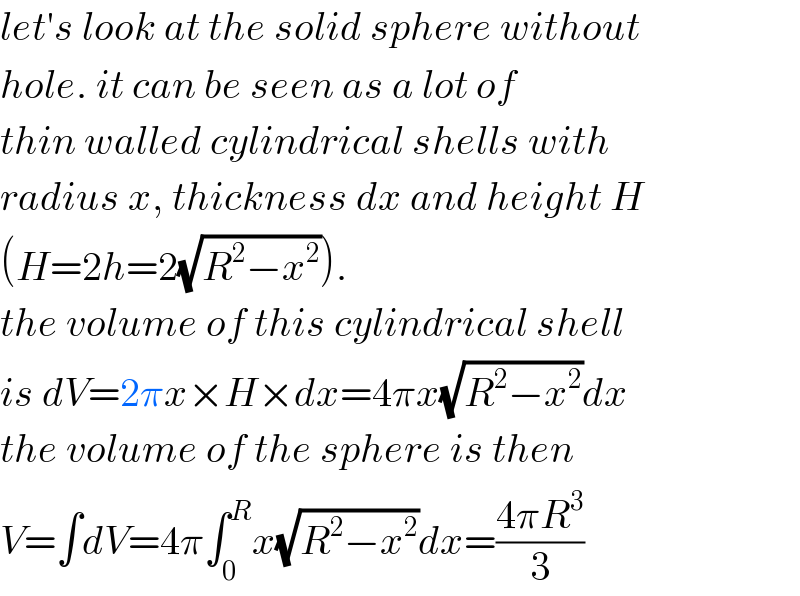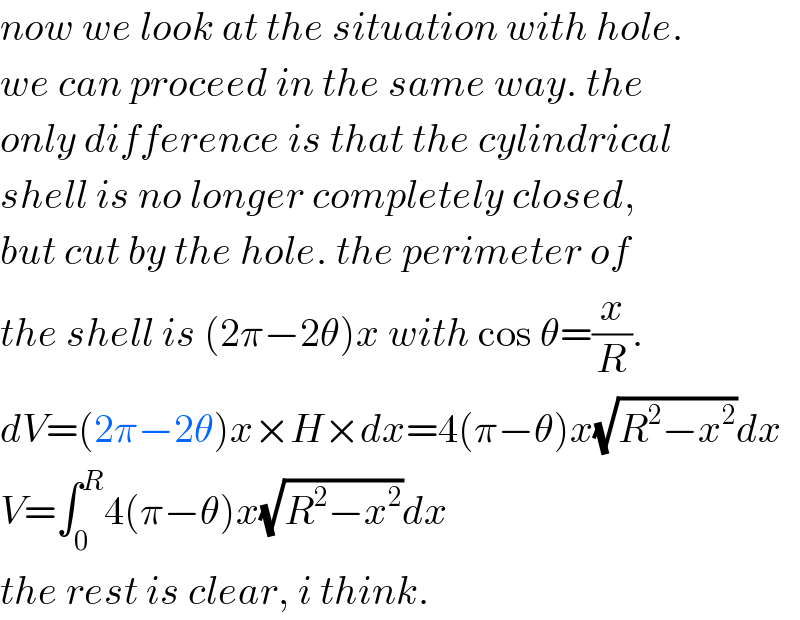Question Number 125215 by ajfour last updated on 09/Dec/20

Commented by ajfour last updated on 09/Dec/20

$${A}\:{cylindrical}\:{hole}\:{of}\:{radius}\:{half} \\ $$$${that}\:{of}\:{the}\:{sphere}\:{is}\:{drilled}\:{out}\:, \\ $$$${touching}\:{the}\:{equatorial}\:{plane}\:{of} \\ $$$${sphere}.\:{Find}\:{fraction}\:{of}\:{volume} \\ $$$${drilled}\:{out}. \\ $$
Commented by mr W last updated on 09/Dec/20
I found something interesting about this problem:
https://diynovice.wordpress.com/2012/12/02/hole-in-sphere/
Answered by mr W last updated on 09/Dec/20

Commented by mr W last updated on 09/Dec/20
![R=radius of sphere x=R cos θ x=0 → R θ=(π/2) → 0 height of shaded cylindrical shell=2h h=(√(R^2 −x^2 ))=R sin θ volume of shaded cylindrical shell: dV=2(π−θ)x×2hdx=−4R^3 sin^2 θcos θ(π−θ)dθ V=4R^3 ∫_0 ^(π/2) sin^2 θcos θ(π−θ)dθ =4R^3 {π[((sin^3 θ)/3)]_0 ^(π/2) −∫_0 ^(π/2) sin^2 θ cos θ θdθ} =4R^3 {(π/3)−(1/9)[3θ sin^3 θ−cos^3 θ+3cos θ]_0 ^(π/2) } =4R^3 {(π/3)−(1/9)[((3π)/2)−2]} =(((2π)/3)+(8/9))R^3 volume of hole: ((4R^3 )/9)(((3π)/2)−2)=(((2π)/3)−(8/9))R^3 fraction=((((2π)/3)−(8/9))/((4π)/3))=(1/2)−(2/(3π))≈28.8% i.e. more than a fourth but less than a third of the sphere is drilled out.](https://www.tinkutara.com/question/Q125221.png)
$${R}={radius}\:{of}\:{sphere} \\ $$$${x}={R}\:\mathrm{cos}\:\theta \\ $$$${x}=\mathrm{0}\:\rightarrow\:{R} \\ $$$$\theta=\frac{\pi}{\mathrm{2}}\:\rightarrow\:\mathrm{0} \\ $$$${height}\:{of}\:{shaded}\:{cylindrical}\:{shell}=\mathrm{2}{h} \\ $$$${h}=\sqrt{{R}^{\mathrm{2}} −{x}^{\mathrm{2}} }={R}\:\mathrm{sin}\:\theta \\ $$$${volume}\:{of}\:{shaded}\:{cylindrical}\:{shell}: \\ $$$${dV}=\mathrm{2}\left(\pi−\theta\right){x}×\mathrm{2}{hdx}=−\mathrm{4}{R}^{\mathrm{3}} \mathrm{sin}^{\mathrm{2}} \:\theta\mathrm{cos}\:\theta\left(\pi−\theta\right){d}\theta \\ $$$${V}=\mathrm{4}{R}^{\mathrm{3}} \int_{\mathrm{0}} ^{\frac{\pi}{\mathrm{2}}} \mathrm{sin}^{\mathrm{2}} \:\theta\mathrm{cos}\:\theta\left(\pi−\theta\right){d}\theta \\ $$$$=\mathrm{4}{R}^{\mathrm{3}} \left\{\pi\left[\frac{\mathrm{sin}^{\mathrm{3}} \:\theta}{\mathrm{3}}\right]_{\mathrm{0}} ^{\frac{\pi}{\mathrm{2}}} −\int_{\mathrm{0}} ^{\frac{\pi}{\mathrm{2}}} \mathrm{sin}^{\mathrm{2}} \:\theta\:\mathrm{cos}\:\theta\:\theta{d}\theta\right\} \\ $$$$=\mathrm{4}{R}^{\mathrm{3}} \left\{\frac{\pi}{\mathrm{3}}−\frac{\mathrm{1}}{\mathrm{9}}\left[\mathrm{3}\theta\:\mathrm{sin}^{\mathrm{3}} \:\theta−\mathrm{cos}^{\mathrm{3}} \:\theta+\mathrm{3cos}\:\theta\right]_{\mathrm{0}} ^{\frac{\pi}{\mathrm{2}}} \right\} \\ $$$$=\mathrm{4}{R}^{\mathrm{3}} \left\{\frac{\pi}{\mathrm{3}}−\frac{\mathrm{1}}{\mathrm{9}}\left[\frac{\mathrm{3}\pi}{\mathrm{2}}−\mathrm{2}\right]\right\} \\ $$$$=\left(\frac{\mathrm{2}\pi}{\mathrm{3}}+\frac{\mathrm{8}}{\mathrm{9}}\right){R}^{\mathrm{3}} \\ $$$$ \\ $$$${volume}\:{of}\:{hole}:\:\frac{\mathrm{4}{R}^{\mathrm{3}} }{\mathrm{9}}\left(\frac{\mathrm{3}\pi}{\mathrm{2}}−\mathrm{2}\right)=\left(\frac{\mathrm{2}\pi}{\mathrm{3}}−\frac{\mathrm{8}}{\mathrm{9}}\right){R}^{\mathrm{3}} \\ $$$${fraction}=\frac{\frac{\mathrm{2}\pi}{\mathrm{3}}−\frac{\mathrm{8}}{\mathrm{9}}}{\frac{\mathrm{4}\pi}{\mathrm{3}}}=\frac{\mathrm{1}}{\mathrm{2}}−\frac{\mathrm{2}}{\mathrm{3}\pi}\approx\mathrm{28}.\mathrm{8\%} \\ $$$${i}.{e}.\:{more}\:{than}\:{a}\:{fourth}\:{but}\:{less}\:{than} \\ $$$${a}\:{third}\:{of}\:{the}\:{sphere}\:{is}\:{drilled}\:{out}. \\ $$
Commented by ajfour last updated on 09/Dec/20

$${Thanks}\:{Sir},\:\:{I}\:{absolutely}\:{agree}\:{with} \\ $$$${and}\:{understand}\:{your}\:{solution}! \\ $$$${Thanks}\:{for}\:{the}\:{effort}\:{and}\:{care}. \\ $$
Commented by mr W last updated on 09/Dec/20

$${h}^{\mathrm{2}} +{x}^{\mathrm{2}} ={R}^{\mathrm{2}} \\ $$$$\Rightarrow{h}=\sqrt{{R}^{\mathrm{2}} −{x}^{\mathrm{2}} } \\ $$
Commented by mr W last updated on 09/Dec/20

Commented by mr W last updated on 09/Dec/20

$${let}'{s}\:{look}\:{at}\:{the}\:{solid}\:{sphere}\:{without} \\ $$$${hole}.\:{it}\:{can}\:{be}\:{seen}\:{as}\:{a}\:{lot}\:{of}\: \\ $$$${thin}\:{walled}\:{cylindrical}\:{shells}\:{with} \\ $$$${radius}\:{x},\:{thickness}\:{dx}\:{and}\:{height}\:{H} \\ $$$$\left({H}=\mathrm{2}{h}=\mathrm{2}\sqrt{{R}^{\mathrm{2}} −{x}^{\mathrm{2}} }\right). \\ $$$${the}\:{volume}\:{of}\:{this}\:{cylindrical}\:{shell} \\ $$$${is}\:{dV}=\mathrm{2}\pi{x}×{H}×{dx}=\mathrm{4}\pi{x}\sqrt{{R}^{\mathrm{2}} −{x}^{\mathrm{2}} }{dx} \\ $$$${the}\:{volume}\:{of}\:{the}\:{sphere}\:{is}\:{then} \\ $$$${V}=\int{dV}=\mathrm{4}\pi\int_{\mathrm{0}} ^{{R}} {x}\sqrt{{R}^{\mathrm{2}} −{x}^{\mathrm{2}} }{dx}=\frac{\mathrm{4}\pi{R}^{\mathrm{3}} }{\mathrm{3}} \\ $$
Commented by mr W last updated on 09/Dec/20

Commented by mr W last updated on 09/Dec/20

$${now}\:{we}\:{look}\:{at}\:{the}\:{situation}\:{with}\:{hole}. \\ $$$${we}\:{can}\:{proceed}\:{in}\:{the}\:{same}\:{way}.\:{the} \\ $$$${only}\:{difference}\:{is}\:{that}\:{the}\:{cylindrical} \\ $$$${shell}\:{is}\:{no}\:{longer}\:{completely}\:{closed}, \\ $$$${but}\:{cut}\:{by}\:{the}\:{hole}.\:{the}\:{perimeter}\:{of} \\ $$$${the}\:{shell}\:{is}\:\left(\mathrm{2}\pi−\mathrm{2}\theta\right){x}\:{with}\:\mathrm{cos}\:\theta=\frac{{x}}{{R}}. \\ $$$${dV}=\left(\mathrm{2}\pi−\mathrm{2}\theta\right){x}×{H}×{dx}=\mathrm{4}\left(\pi−\theta\right){x}\sqrt{{R}^{\mathrm{2}} −{x}^{\mathrm{2}} }{dx} \\ $$$${V}=\int_{\mathrm{0}} ^{{R}} \mathrm{4}\left(\pi−\theta\right){x}\sqrt{{R}^{\mathrm{2}} −{x}^{\mathrm{2}} }{dx} \\ $$$${the}\:{rest}\:{is}\:{clear},\:{i}\:{think}. \\ $$
Commented by mr W last updated on 09/Dec/20

Commented by talminator2856791 last updated on 10/Dec/20

$$\:\mathrm{did}\:\mathrm{you}\:\mathrm{make}\:\mathrm{this}\:\mathrm{diagram}\:\mathrm{on}\:\mathrm{here}? \\ $$$$ \\ $$
Commented by mr W last updated on 10/Dec/20

$${no}.\:{i}\:{made}\:{the}\:{diagrams}\:{in}\:{other} \\ $$$${apps}. \\ $$
Answered by ajfour last updated on 09/Dec/20

